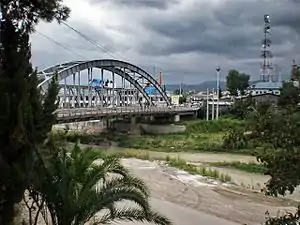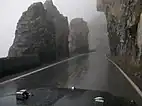Chalus, Iran
Chalus (Persian: چالوس; Mazandarani: Chāles ;romanized: Chālūs, Chaloos, Chalousse, Chalous, and Čâlus)[3][4] is a city in, and the capital of, the Central District of Chalus County, Mazandaran province, Iran, and also serves as capital of the county.
Chalus
Persian: چالوس | |
|---|---|
City | |
 Seal | |
 | |
 Chalus | |
| Coordinates: 36°39′17″N 51°25′16″E[1] | |
| Country | Iran |
| Province | Mazandaran |
| County | Chalus |
| District | Central |
| Government | |
| • Type | Mayor, City Council |
| • Mayor | Masud Yaqubi |
| • Representative in Majles | MohammadAli Mohseni Bandpey |
| Population (2016)[2] | |
| • Total | 65,196 |
| Time zone | UTC+3:30 (IRST) |
| Website | chalus |
Population
At the 2006 census, its population was 44,618 in 12,791 households.[5] The following census in 2011 counted 47,881 people in 15,077 households.[6] The latest census in 2016 showed a population of 65,196 people in 22,166 households.[2]
The people residing in Chalus speak western dialect of Mazanderani language. In the west of chalus, the Kalarestaqi dialect is spoken, and in the east of chalus, people speak in Kojuri dialect.[7][8]
Mazandarani people have a background in Tabari ethnicity and speak Mazandarni. Their origin goes back to Tapuri people. So their land was called Tapuria, the land of Tapuris. Tapuris were made to migrate to the south coast of the Caspian Sea during the Achaemenid dynasty.[9][10][11]
The native people of Sari, shahi, babol, Amol, Nowshahr, Chalus, and Tonekabon are Mazandarani people and speak the Mazandarani language.[12][13]
The eastern Gilaki is spoken in the entire valley of the Čālūs river, though some Kurdish tribes were established in the yeylāq of Kojūr and Kalārdašt in the Qajar period.[14]
History
In the past, Chalus was to be called "Salus" and "Shalus" under the influence of arabic. It has a long history of rebels and fights with regional rulers or occupying foreign forces. Chalus used to have a large silk factory that was active from 1936 to 1958, and exported fabrics and other silk products to different countries.
Chalus is part of the Kelarestaq area of Ruyan (Tabaristan). Ruyan was an ancient land in the west of Mazandaran Province during the Baduspanids era. This land includes Kojur, Kelarestaq and Tonekabon. The city of Kojur was the centre of the land of the Ruyans. Ruyan has always been part of the Tabaristan, nowadays called Mazandaran province. The Ruyan was also called the Rostamdār, Ostandār and Rostamdele.[7]
Geography
The city is in the Mazandaran Province in northern Iran. The bordering counties are Noshahr to the east, Tonekabon to the west in Mazandaran province and Tehran province to the south. It sits on the Chalus River by the Caspian.
Climate
Chalus has a humid subtropical climate (Köppen: Cfa, Trewartha: Cf), with warm, humid summers and cool, damp winters.
Tourism
Chalus is a major vacation destination for Iranians during holidays for its nice weather and natural attractions. One of the great attractions of Chalus is the mountainous road leading to Chalus, widely known as Chalus Road. This city has a reputation for a number of villages, one of which is called Namakab Rud. This town offers a variety of different entertaining activities, such as a cable car, offering a view of the surrounding mountains.
Gole Sorkhi, Mohavateh Kaakh (The Palace), Chalus Mahalleh, Radio Darya, Dahgiri, Sheykh Ghotb are among the most notable neighborhoods of Chalus.
The Taliesin Associated Architects (Frank Lloyd Wright Foundation) had three buildings built in Iran, one of which was the summer residence of Shams Pahlavi known as Mehrafarin Palace in Chalus (presently occupied by the local police).[15]
See also
References
- OpenStreetMap contributors (23 May 2023). "Chalus, Chalus County" (Map). OpenStreetMap. Retrieved 23 May 2023.
- "Census of the Islamic Republic of Iran, 1395 (2016)". AMAR (in Persian). The Statistical Center of Iran. p. 02. Archived from the original (Excel) on 7 October 2021. Retrieved 19 December 2022.
- Chalus, Iran can be found at GEOnet Names Server, at this link, by opening the Advanced Search box, entering "-3057857" in the "Unique Feature Id" form, and clicking on "Search Database".
- Hourcade, Bernard (15 December 1990). "ČĀLŪS". Encyclopaedia Iranica, Vol. IV, Fasc. 7. pp. 720–722. Archived from the original on 29 April 2011. Retrieved 22 January 2019.
- "Census of the Islamic Republic of Iran, 1385 (2006)". AMAR (in Persian). The Statistical Center of Iran. p. 02. Archived from the original (Excel) on 20 September 2011. Retrieved 25 September 2022.
- "Census of the Islamic Republic of Iran, 1390 (2011)" (Excel). Iran Data Portal (in Persian). The Statistical Center of Iran. p. 02. Retrieved 19 December 2022.
- Borjian, Habib (31 July 2010). "KALĀRESTĀQ i. The District and Sub-District". Encyclopaedia Iranica, Vol. XV, Fasc. 4. Sohrāb Eḥsāni (local informant). pp. 367–369. Archived from the original on 29 April 2011. Retrieved 7 April 2021.
- Borjian, Habib (26 June 2013). "KOJUR i. Historical Geography". Encyclopaedia Iranica. Archived from the original on 17 November 2013. Retrieved 7 April 2021.
- Borjian, Habib (2004). "Māzandarān: Language and People". Iran & the Caucasus. Brill. 8 (2): 291. doi:10.1163/1573384043076045. JSTOR 4030997.
- "Dictionary of Greek and Roman Geography, illustrated by numerous engravings on wood. William Smith, LLD. London. Walton and Maberly, Upper Gower Street and Ivy Lane, Paternoster Row; John Murray, Albemarle Street. 1854. ,TAPU´RI". www.perseus.tufts.edu. Retrieved 4 February 2021.
- Potts, Daniel (2014). Nomadism in Iran: From Antiquity to the Modern Era. Oxford University Press. p. 110. ISBN 9780199330799. Retrieved 15 December 2021.
- "Glottolog 4.6 - Mazanderani".
- Windfuhr, G. L. 1989. New Iranian languages: Overview. In Rüdiger Schmitt, ed., Compendium linguarum Iranicarum. Wiesbaden: L. Reichert. pp. 490.
- Foundation، Encyclopaedia Iranica. «Welcome to Encyclopaedia Iranica». iranicaonline.org
- Kasraie, Nima (4 June 2004). "Spiraling into Oblivion, A film by Ken Burns and Lynn Novick". The Iranian. Archived from the original on 27 May 2020. Retrieved 7 April 2021.


.jpg.webp)